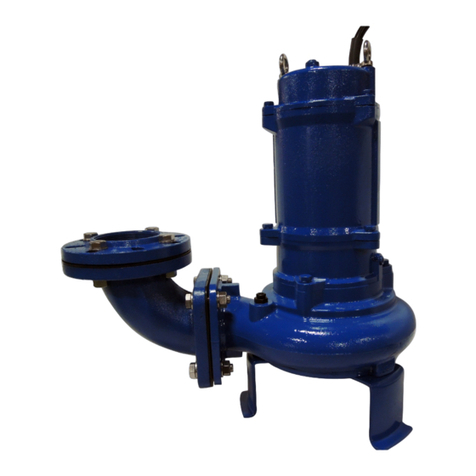3
The following components must be installed in the delivery pipe :
A pressure gauge ;
A check valve at max. 7m from the pump outlet and more lift-type check valves (5), depending on the type of
installation ( at least on every 50m in the straight vertical pipe above the pump ), to provide protection against
water hammering ;
A gate valve to regulate delivery , head and absorbed power.
If the submersible pump is to be installed in the horizontal position , the following instructions must be followed:
Install the pump with its axis placed at least 0 , 5m above the bottom of the sump , tank or container.
Install a supplementary check valve , as the pump valve does not ensure a perfect seal in the horizontal position.
The plant must allow for easy evacuation of the air when starting .
4.1. Motor cooling
If the well ( or tank ) has a diameter which is considerably greater than the pump width , it is necessary to install a
cooling flow shroud ( a flow inducer sleeve ), that is an external jacket to ensure a sufficient flow and water velocity
( V ≥0,08m/s for 4” , 0 , 16m/s for 6” ) to cool the motor.
5. Assembly of the pumps
The pumps are normally supplied with motor and pump disconnected.
Connect the coupling and pump-motor suction lantern. Clean the surface to be coupled. Put the suction
lantern of the pump in correspondence of the motor studs. Couple the grooved joint of the pump to the
motor shaft.
Screw in the nuts to the suction lantern, then fix them crosswise starting from the one opposed to the
cable as shown in the figure below. The torque recommended is 10Nm (for 4” motors).
Attach the cable to the pump with the cable guard and place the filter on the suction lantern.
Follow separate operating instructions (if available) of the motor.
6.Electrical connection
Electrical connection must be carried out only by a qualified electrician in accordance with local regulations.
Follow safety standards.
The unit must be properly earthed (grounded), also with a nonmetallic delivery pipe.
Make sure the frequency and mains voltage correspond with the name plate data.
Please follow the instruction of motor supplier for the motor electrical wiring.
6.1. Connection of cables
Feed cables have to be chosen on the basis of power , distance , voltage drop and temperature.
For connection of cables in the well , use thermo-shrinking insulation sheathes or other systems used for submerged
cables.
Before lowering the motor into the well , use appropriate instruments to measure continuity between phases and per-
form an isolation test between each single phase and the earth conductor.
7.Starting
Start the pump with the gate valve regulated to minimum aperture and wait until the delivery pipe is com-
pletely free of air.
With a three-phase motor make sure the direction of rotation is correct.
For this purpose , with the gate valve at half-open aperture position , check the pressure (with the pressure gauge) or
flow rate (sight check) after starting. Switch off power , reverse the connections of two phases on the control panel ,
re-start and check the pressure or flow rate capacity again.
The correct direction of rotation will provide a considerably greater and easily distinguishable pressure and delivery
capacity.
Make sure the sand residue present in the water disappears or is minimal.
Never start or run the pump when the gate valve has been opened too widely.
Make sure the pump operates within its rated limits of performance and that the rated absorbed cur-
rent is not exceeded.
Otherwise , regulate the delivery gate valve or the setting of any pressure switches.
7.1. Generator supply
The switching sequence is of utmost importance.
If you do not apply this correctly , both motor and generator may be damaged.
Therefore :
- Always switch the generator on and off without load!
This means :
- Starting : always switch the generator On first and the motor afterwards!
- Stopping : always switch the motor OFF first and the generator afterwards!
ATTENTION : Never run the pump dry , not even for a short trial run.
ATTENTION : Avoid long periods of operation with closed discharge.
8.Maintenance
Under normal operating conditions with clean water the pump will not require maintenance.
Absorbed current and head supplied by the pump must be checked at regular intervals.
This procedure should be carried out frequently when water contains considerable quantities of sand.
In the case of emergency systems , it is advisable to operate the pumps once a month in order to avoid the risk of
blocking and to maintain and verify perfect efficiency.
Disconnect electrical power before any servicing operation.
Caution





























